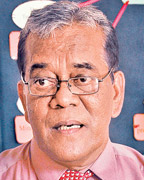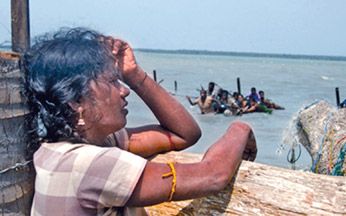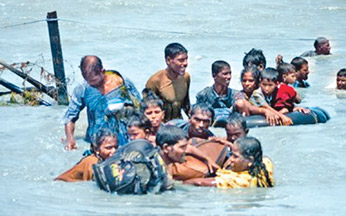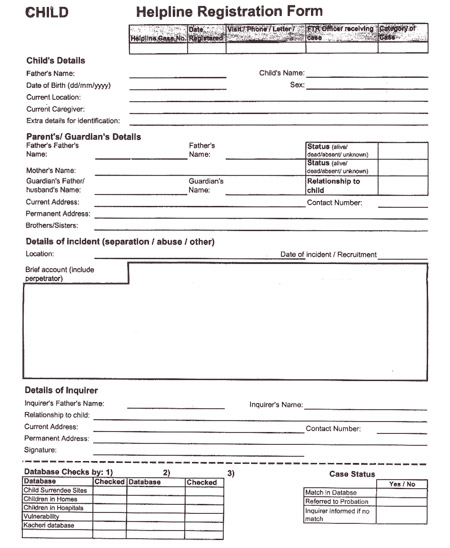|
Family Tracing and Reunification Unit, Kilinochchi:
Linking displaced family members in the North
by Kurulu Koojana Kariyakarawana and Dhaneshi
Yatawara
 |
|
Brig. J.B. Galgamuwa
(Rtd.) |
Losing a loved one can be extremely painful whether it is a parent,
an offspring or a sibling. A death of a family member could agitate
somebody for the rest of his life or perhaps until the memory fades away
after getting the notion that the lost person will never return. But
losing someone in a conflict environment and having to live with the
doubt whether that person is still alive or not can be far painful than
the former.
Thousands suffered due to losses of their loved ones in the three
decade old war and many families were left scattered with their members
missing during the displacement of the final stages of the humanitarian
mission.
All displaced persons and families were moved into temporary camps in
the North following the liberation of the lands from the clutches of the
LTTE and they were settled under makeshift roofs. Food, water and
essential healthcare was supplied to these people which was a great
relief to them during that stage. However, the agitation of losing their
homes and loved ones was not small where the involvement of a third
party was necessary to bring the peace back to their lives.
Shelter
Jhoncy is a teenage girl of a family of five siblings lived in Wanni,
who was separated from her two brothers during the war and had to flee
in seek of shelter in Manik Farm in Vavuniya. In February 2010 she came
across some posters about a helpline and an organisation called FTR
pasted on a tree trunk within the camp, that had offered assistance to
find the missing members of the displaced families. She immediately
contacted the helpline and the FTR found a match to her 12-year-old
missing brother Robin on the same day, who was living at a house in
Mannar by then. Within a month Johncy was able to meet her brother.
Family Tracing and Reunification (FTR) is a special unit set up to
find the missing members of the displaced families and reunite them. It
was established in December 2009 by the Department of Probation in
collaboration with the Vavuniya Government Agent P S M Charles and
Commissioner of Department of Probation and Child Care Services of the
Northern Provincial Council Wishwa Ruban with the financial backing of
the UNICEF.
 |
|
Suppaiah Subramanium reunited with his
son Vidusha
after four years |
Head of FTR, Brigadier J B Galgamuwa (Rtd.) said that there were lot
of displacements during the final stages of the war and reunification of
families was an important thing to be done as soon as the war ended in
May 2009. This was started within the Manik Farm where both families and
children were reunified. The unit has received a total of 2,434
applications of missing adults and children so far and 1,686 of them are
adult applications. There are 1,170 male applications and 516 female
applications. The unit has received a total of 748 children's
applications of 387 are boys and 361 are of girls. However the priority
is given to reunifying children presently instead of reuniting the
adults which would be another project.
The office of the FTR is situated in a family entertainment and
recreation complex called Harmony Centre in Kilinochchi, put up by the
Sri Lanka Army. The aforesaid figures of applications were received when
the FTR was formed and prior to that 615 children who were living in the
Manik Farm had been reunified with their families under the patronage of
the Northern Province Governor Major General G A Chandrasiri who was
then competent authority of the Internally Displaced People.
Helpline
When the FTR was established a helpline and database was introduced
which were the main components. Then the tracing was started in 2010
covering 13 districts countrywide. The unit began collecting all the
names of the children during this period through hospitals, police
posts, IDP camps, military entry/exit points and from shiploads of
people being brought in from other coastal areas. The unit has collected
over 100, 000 children's names during the first year and started tracing
the names with the 748 individual children's applications that were in
the database. The tracing managed to match 148 names in the database.
They were referred to probation for tracing, verification and
reunification. Out of the matched 148 names 48 children were reunified
with their parents or the families.
The unit has prepared a special registry of details of the 748
applicants with their pictures. This was helpful when a father came in
search of his son who had been missing since 2009. Before recording his
entry the registry was shown to him whether to see his son is among the
individuals listed in the book.
He had found his son in the registry and come to know that his son is
still among the living even after four years. The father, Suppaiya
Subramaniam who was living in Kilinochchi met his son Subramanium
Vidusha who was living in a children's home in Vavuniya.
 |
|
May 2009 - a mother looking for her
child
Pix: Susantha Wijegunasekara and Thilak Perera |
The father had even taken the son's death certificate during this
period thinking his son is no more. Because of this complication the
reunification of the father and son has to be done through a court of
law. Only a judge has the authority to pass the order to probation
centre to hand over the child to his father. It will cancel the boy's
death certificate as well.
Similar to this there are several other cases that the law has to be
sought in order to reunify the children with their parents. In another
case a DNA test has to be taken from the child and the parents as two
different persons claim the child.
As in any reunification program, this is an ongoing initiative and it
might take years to find a resolution to most of the cases pending with
the unit. One of the recent matches the unit found was of a child who
died in a hospital of his injuries from the conflict. It was not a happy
ending but a resolution nevertheless.
The task ahead for the FTR is to resolve the pending cases one by
one. It may not always be a pleasant exercise and not all of them will
have happy endings such as this. But the ultimate joy one could gain by
engaged in this kind of work is to see the relieving signs of the
parents and the children embracing each other in tears, the Brigadier
added in a self satisfied manner.
************
Nidarshan - Was it simply his kismet that made him come back home?
In 2010, the Provincial Department of Probation and Childcare of the
Northern Province, during one of the registration processes that was
carried out in one of the welfare centres in Vavuniya, found a man
keeping a boy claiming as his son but without no other evidence. The
situation was highly suspicious that lead to the officers to inquire
more in to the issue. Following several folds of inquiries the Probation
officers found this boy was one of the children the department was
already looking for based on complaints from the parents.
The boy, known as Nidarshan, have lost his family while escaping the
No fire Zone in January 2009 under the LTTE attacks on the escapees.
With the investigations carried out by the probation officers proved
that the man who claimed to be the father of the boy was using the child
as a cover up to protect his true identity as a LTTE member.
Tracing back to the beginning, the story of the missing Nidarshan
runs back to January 2009. Nidarshan has been just a old toddler when
his parents had to move from their village in Kilinochchi with his two
sisters. The girls were just six and two. Forced by the LTTE the family
along with many other families retreated deeper in to Vanni jungle and
finally reached Puthumathalan. Until then these people were running for
safety in every possible direction and turning back only Nidarshan's
mother realised that her brother who was carrying Nidarshan was missing.
In Puthumathalan Nidarshan's family find the uncle wounded. Though
Nidarshan's uncle ran as fast as he could to save his little nephew he
got shot and fell. With this chaotic situation the uncle lost Nidarshan.
Escaping from the LTTE side this family reaches the welfare centres
and went from one officer to another inquiring about their child. When
the FTR was opened they came to them as well. Investigating hundreds of
cases everyday and matching all details with complaints the FTR finally
traced Nidarshan living with an unknown man.
This case was referred to the courts by the Probation officers and
the boy was rescued and the accused man was arrested. According to the
FTR records on January 9, 2010 the Courts ordered to reunify Nidarshan
with his family.
************
Maheshwari, Ilajjanaa and Yathusuran - moving beyond the gloomy days
When Maheshwari returned to Sri Lanka from Middle East in 2008 she
saw a totally transformed home town. The town she was born and brought
up, Batticaloa was a different world. Batticaloa and the entire Eastern
Province was fast loosing traces of a gloomy past and so were traces of
the children's home where she left her two precious little ones two
years ago. She searched in every possible nook and corner and knocked on
many doors looking for her two children, daughter Ilajjanaa and son
Yathusuran. She earned money but the very strength that kept her living
was missing.
 |
|
Civilians escaping on
May 2009, crossing the Nanthikadal lagoon |
In 2006, when she opted to migrate to the Middle East to support her
two children Maheshwari had no choice but to leave them in an LTTE run
orphanage. Her husband, Gnanamuththu was gunned down by armed men in
2005. The tragedy was a broad day light murder that left Maheshwari
alone in this world with her two children. Ilajjanaa was five and
Yathusan had just turned two. Young and pretty Maheshwari soon had to
keep her head up and soon find a way to feed and look after her children
before her life gets from bad to worse. It was then she decided to go
for employment in the Middle East as many of the women in her village
did.
Returning in 2008 her efforts to look for her children's whereabouts
were failed. The more she tried the more she became dubious to the
military intelligence. No place to stay and no family to be with,
Maheshwari went abroad again. When she heard that East is totally back
to normalcy, she returned to her village in early 2009. Luckily she
meets another family living in her village who had found their child
back through the Family Tracing and Reunification (FTR) Unit operated
under the Provincial Department of Childcare and Probation in the
Northern Province. Keeping fingers crossed Maheshwari tried her luck in
finding her innocent children. Within months Maheshwari found her
missing children - quicker than she lost them.
Even today ten year old Yathusuran do not recognise his mother
Maheshwari, whom he lost contact eight years ago. His sister Ilajjanaa,
now thirteen, remembered the mother - her only guardian left on this
earth. Ilajjanaa was found living in a children's home in Vavuniya. The
son, who lost contact with the mother when he was just two, could not
identify her. The mother still continue to visit the son hoping that one
day he will come up with stories he could remember in their happy days.

|


